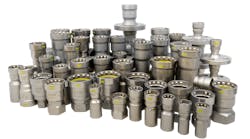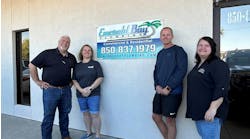BY ROBERT P. MADER
OF CONTRACTOR'S STAFF
ST. LOUIS — Haberberger Mechanical here has completed the mechanical piping work at a membrane bio-reactor technology wastewater treatment facility in the Wyndgate Subdivision in O'Fallon, Mo. The plant is unlike any other in the area in that it's located within an 8,000-sq.-ft. house amongst the other houses in the subdivision. The facility represents a creative new trend for disguising wastewater treatment facilities in populated areas.
Haberberger started work in October 2005 and was finishing a couple punch-list items at press time. The ribbon cutting is scheduled for sometime in September.
Wyndgate developer T.R. Hughes hired Haberberger as a subcontractor to complete all the piping, sheet metal, HVAC and process piping work for the plant. Pat Reilly led Haberberger as project manager for the new facility, which consists of one of the newer technologies on the market today. Behind decorative curtains and fresh landscaping lies an odorless, noise-free facility with capabilities that enable it to be positioned directly near homes and families who see it as being just as appealing as the house next door.
Haberberger has had plenty of experience in the sewage-treatment arena, Reilly noted, and has built numerous lift stations. He said he believes that consulting engineer Archer Engineering suggested the firm to T.R. Hughes.
Haberberger worked under a negotiated contract. Hughes is evidently happy, because Reilly said the contractor has three more projects underway with the developer.
Reilly built the plant with an average crew of four from United Association Local 562. They had a few puzzling moments, Reilly said, because the engineer's drawings didn't always match the drawings of the supplier of the MBR. The plant also came in "1,000 pieces," he noted.
T.R. Hughes and the Ducket Creek Sanitary District made a proactive decision to invest in MBR by recognizing the technology's long-term benefits for serving the 800-home subdivision and future developments. The MBR technology allows the district to greatly reduce the footprint of a conventional plant because it minimizes the size of the facility while at the same time enhancing the quality up to 10 times. The technology reduces the concerns of conventional plants that flow directly into streams.
"We're doing now what would have needed to be done in the future to adhere to state regulations," said Keith Arbuckle, director of engineering for Ducket Creek Sanitary District. "MBR plants operate more efficiently and don't offer the concerns of conventional facilities."
The MBR technology is relatively new in the United States but has been used for decades in Europe and Japan, where more stringent environmental regulations apply. Canadian-based Zenon, a firm that recently was purchased by General Electric, created the technology used for the Wyndgate development.
An MBR uses the same biology as a conventional sewage treatment plant, but instead of letting nature separate the water from the sludge by gravity, it speeds the process by forcing it through a membrane filter, explained Tom Engle, executive director of the Ducket Creek Sanitary District.
"In a nutshell," Arbuckle said, "this technology allows it to be one-third the size of a conventional sewage treatment plant and produce five to 10 times cleaner effluent."
The MBR plant is so clean, Engle noted, that it discharges into a stream that the Missouri Department of Natural Resources had designated as a non-discharge stream, but the plant discharge is three to four times cleaner in terms of background pollutants and bacteria than the water in the stream.
The sanitary district began looking at MBR technology five years ago, Engle said, but it was so rare that staff had to travel to Europe to see one in operation. The plants are significantly more expensive but use far less valuable real estate and are energy efficient.
Today about 150 MBR plants are in operation in the United States and about another 50 under construction. Most of the plants are on either coast, two are in Atlanta and a couple more are in Michigan. The Wyndgate plant and a second now under construction are the first in Missouri.
As developers push farther out from cities and central plants, they are running out of sewage treatment options, Engle and Arbuckle explained. Building lift station after lift station after lift station to reach a central plant becomes impractical. Both the Missouri DNR and the EPA are discouraging packaged treatment plants because the effluent coming from them is too dirty. Consequently, a developer in a remote location can choose to not build, build on three-acre lots with septic systems or use an MBR.
Haberberger is working on a second MBR wastewater treatment facility, the Riverdale Facility, located in St. Paul, Mo. The plant, in a more bucolic-style development, is masked by an oldfashioned red barn.
Haberberger, Inc. is a 58-year-old, contracting company offering process piping and piping fabrication, HVAC installation, customized maintenance programs, and refrigeration and energy management services to a variety of industrial and commercial customers.
Additional information is available at www.haberbergerinc.net

